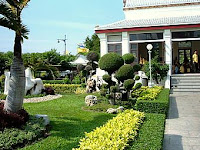Sao Lak Muang
 According to an old Thai tradition, a city pillar had to be built upon the establishment of a new city. King Rama I had the Bangkok city pillar erected near the Temple of the Emerald Buddha on Sunday, 21 April, 1782, with the city's horoscope inside. The original pillar was made of cassia wood known as Chaiyaphruek, measuring 75 cm. in diameter and 27 cm. high. In the reign of King Rama IV, the old dilapidated pillar was replaced by a new one made of the same kind of wood, measuring 270 cm. high and standing on a base of 175 cm. wide, sheltered by a Prang-shaped shrine as it appears today. The shrine also houses images of protective deities including Thepharak, Chaopho Ho Klong, Phra Suea Mueang, Phra Song Mueang, Chaopho Chetakhup and Phra Kan Chai Si.
According to an old Thai tradition, a city pillar had to be built upon the establishment of a new city. King Rama I had the Bangkok city pillar erected near the Temple of the Emerald Buddha on Sunday, 21 April, 1782, with the city's horoscope inside. The original pillar was made of cassia wood known as Chaiyaphruek, measuring 75 cm. in diameter and 27 cm. high. In the reign of King Rama IV, the old dilapidated pillar was replaced by a new one made of the same kind of wood, measuring 270 cm. high and standing on a base of 175 cm. wide, sheltered by a Prang-shaped shrine as it appears today. The shrine also houses images of protective deities including Thepharak, Chaopho Ho Klong, Phra Suea Mueang, Phra Song Mueang, Chaopho Chetakhup and Phra Kan Chai Si.The original site of the city pillar was at the southwestern corner of Sanam Luang. However, rumor has it that on the day the pillar was raised, four snakes crawled under the shrine and were killed. Soothsayers interpreted this as an ominous sign that Bangkok would only last as the capital for 150 years.In the reign of King Rama IV, these rumors were promptly squashed. Well-versed in astrology, King Rama I chose an auspicious date to rebuilt the city pillar on a more auspicious site. On 05 December 1853, the city pillar was rebuilt in the southeastern corner of Sanam Luang, across the road from the Grand Palace, where it remains to this day.
Lak Muang or the City Pillar Shrine consists of a square building with openings on all four sides. In the center of the room are two gold pillars and six elephant tusks. The roof has three levels of ornate gables on each side and a dazzling white multi-tier square spire.King Rama I also included three guardian angels for the new capital city shrine. Two of these guardian angels are in the Theparat Shrine, just to the right of the main shrine as you enter from Lak Muang Road. At the center of the Lak Muang complex is a simple shed with an altar where it's usual to see devotees pray and make offerings of food and flowers. To the side is a huge table laden with food and four bowls of holy water for people to wash hands and faces.
At the other end of the garden is another building also with an altar where others can be seen praying. Traditional dancers can be seen performing on a nearby stage as part of the thanksgiving ceremony.
Take a rest under the shady sala or pavilion and watch the ceremonies and proceedings. As an auspicious place, it's customary for residents to come to the shrine to make wishes.
When their wishes come true, they reciprocate with prayers and offerings of food and flowers. From the number of devotees and food at the shrine, many wishes must have come true.
Lak Muang or the City Pillar Shrine represents the foundation stone of Bangkok, the start point of the city and the Rattanakosin era. It's the origin of a capital city and a dynasty that's more than 220 years old!
Major restoration to the Bangkok City Pillar Shrine
The City Pillar Shrine or Sao Lak Muang has undergone a major facelift to restore the national monument to its former glory.
This is the first major restoration work in 20 years. Over the years, corrosion and deterioration has caused the shrine to be a dilapidated state. The work was completed in February 2007.
You can check all the accommodations in Bangkok including prices, transportations, activities, etc. here, Bangkok Hotels.





ไม่มีความคิดเห็น:
แสดงความคิดเห็น